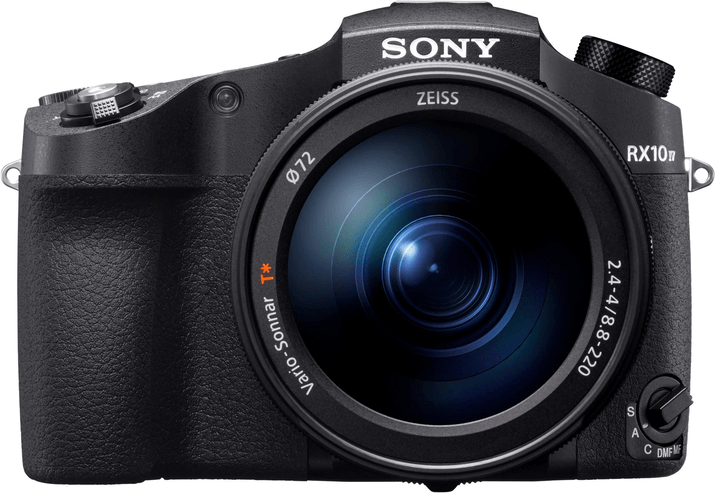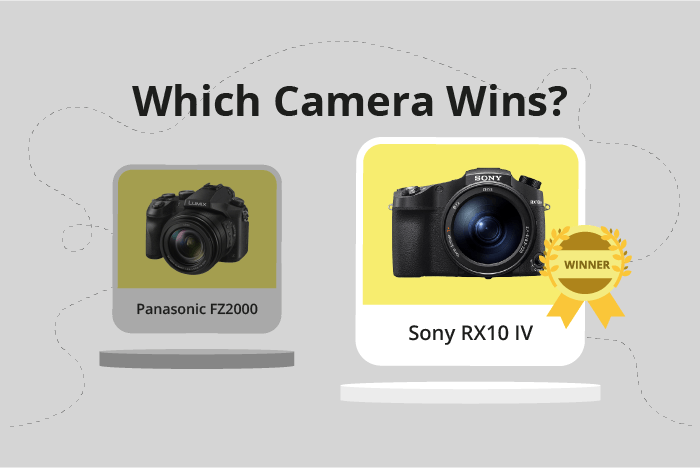Panasonic Lumix DMC-FZ2000 / FZ2500 vs Sony Cyber-shot RX10 IV Comparison
Panasonic Lumix DMC-FZ2000 / FZ2500

Sony Cyber-shot RX10 IV

The Sony Cyber-shot RX10 IV takes the lead in our comparison with a score of 70/100, while the Panasonic Lumix DMC-FZ2000 / FZ2500 trails behind with 63/100. Both cameras are bridge type and were released a year apart, with the Panasonic in 2016 and the Sony in 2017. They share similarities in size, with the Lumix measuring 138 x 102 x 135mm and the RX10 IV at 133 x 94 x 145mm.
The Sony RX10 IV outshines the Panasonic Lumix FZ2000/FZ2500 with its higher score, reflecting its superior performance and features. However, the Lumix has an advantage in weight, being lighter at 915g compared to the Sony’s 1095g. This makes the Panasonic more portable and convenient for on-the-go photography.
Despite the Panasonic’s lower score and older release date, it still offers a competitive option with a lower launch price of $1199, compared to the Sony’s $1699. This makes the Lumix a more budget-friendly choice for those seeking a capable bridge camera.
Taking all factors into consideration, the Sony Cyber-shot RX10 IV is the better camera with its higher score, but the Panasonic Lumix DMC-FZ2000 / FZ2500 remains a viable alternative for those prioritizing weight and cost.
Panasonic Lumix DMC-FZ2000 / FZ2500 vs Sony Cyber-shot RX10 IV Overview and Optics
The Sony Cyber-shot RX10 IV outperforms the Panasonic Lumix DMC-FZ2000 / FZ2500 in optics with a score of 68/100 compared to the Panasonic’s 62/100. Both cameras share similarities in specifications, such as 20-megapixel CMOS sensors, 1″ sensor sizes, fixed lens mounts, and image stabilization.
The RX10 IV’s superiority in optics is evident in its faster shooting speed of 24 frames per second (fps), compared to the FZ2000/FZ2500’s 12 fps. Additionally, the Sony camera’s Bionz X processor contributes to its advanced image processing capabilities, resulting in a higher DXOMARK score of 82, while the Panasonic’s Venus Engine processor yields a score of 70.
However, the Panasonic Lumix DMC-FZ2000/FZ2500 does have its advantages. Although it has a lower optics score, it remains a solid choice for those seeking a high-quality camera with a slightly lower price tag. The Panasonic camera’s specifications, such as the 20-megapixel CMOS sensor and image stabilization, are still competitive and provide satisfactory results for various photography purposes.
Taking all factors into account, the Sony Cyber-shot RX10 IV is the better option in terms of optics, with a faster shooting speed and superior image processing capabilities. Nonetheless, the Panasonic Lumix DMC-FZ2000/FZ2500 is a viable alternative for those prioritizing budget constraints without sacrificing too much on performance.
Panasonic Lumix DMC-FZ2000 / FZ2500 vs Sony Cyber-shot RX10 IV Video Performance
The Sony Cyber-shot RX10 IV outperforms the Panasonic Lumix DMC-FZ2000 / FZ2500 in video capabilities with a score of 77/100 compared to 69/100. Both cameras share some common specifications, such as 4K max video resolution and the lack of built-in time-lapse functionality.
The RX10 IV has a higher max video frame rate at 120fps, double the FZ2000 / FZ2500’s 60fps. This higher frame rate allows for smoother and more detailed slow-motion video capture, making the RX10 IV a better choice for those who prioritize this feature.
On the other hand, the FZ2000 / FZ2500 has a slightly larger max video dimensions at 4096 x 2160, compared to the RX10 IV’s 3840 x 2160. However, this difference in dimensions is relatively small and may not significantly impact the overall video quality.
Despite the larger dimensions, the FZ2000 / FZ2500 falls short in its video capabilities due to its lower frame rate. The RX10 IV’s higher frame rate offers more flexibility in capturing fast-paced action and producing smoother slow-motion footage.
In terms of video performance, the Sony Cyber-shot RX10 IV is the better option with its higher score and superior frame rate capabilities. The Panasonic Lumix DMC-FZ2000 / FZ2500 has a minor advantage in video dimensions but is not enough to outweigh the benefits of the RX10 IV.
Panasonic Lumix DMC-FZ2000 / FZ2500 vs Sony Cyber-shot RX10 IV Features and Benefits
The Sony Cyber-shot RX10 IV emerges as the winner in the feature comparison, scoring 83/100, while the Panasonic Lumix DMC-FZ2000 / FZ2500 scores 70/100. Both cameras share several common specifications, including a 3-inch screen size, touchscreen functionality, flip screen, GPS absence, and the presence of WIFI and Bluetooth.
The Sony RX10 IV surpasses the Panasonic FZ2000 / FZ2500 with a higher screen resolution of 1,440,000 dots, compared to the Panasonic’s 1,040,000 dots. This higher resolution provides the Sony RX10 IV with a sharper and clearer display, enhancing the user experience while composing shots and reviewing images.
On the other hand, the Panasonic FZ2000 / FZ2500 still has its merits despite its lower feature score. Its features are on par with the Sony RX10 IV in many aspects, such as screen size, touchscreen, flip screen, and connectivity options. While the screen resolution is lower, it remains adequate for most users and should not be a dealbreaker.
In comparing the features of these cameras, the Sony Cyber-shot RX10 IV proves to be the superior choice due to its higher screen resolution, which offers a better user experience. The Panasonic Lumix DMC-FZ2000 / FZ2500, while scoring lower, maintains competitive features and may still be a suitable option for users who prioritize other aspects of a camera over screen resolution.
Panasonic Lumix DMC-FZ2000 / FZ2500 vs Sony Cyber-shot RX10 IV Storage and Battery
The Sony Cyber-shot RX10 IV outperforms the Panasonic Lumix DMC-FZ2000 / FZ2500 in storage and battery, scoring 37/100 compared to the Panasonic’s 35/100. Both cameras have one memory card slot and accept SD, SDHC, and SDXC cards. They also support USB charging.
The RX10 IV has an advantage in battery life, providing 400 shots per charge with its NP-FW50 battery, while the FZ2000/2500 offers 350 shots using the DMW-BLC12 battery. Additionally, the Sony model accepts Memory Stick Duo, Pro Duo, and Pro-HG Duo cards, giving users more flexibility in storage options.
Although the Panasonic Lumix FZ2000/2500 has a slightly lower score, it still provides adequate battery life and storage capabilities for most users. Both cameras offer reliable performance in these aspects, but the Sony RX10 IV holds a slight edge due to its longer battery life and expanded memory card compatibility.
Panasonic Lumix DMC-FZ2000 / FZ2500 vs Sony Cyber-shot RX10 IV – Our Verdict
Are you still undecided about which camera is right for you? Have a look at these popular comparisons that feature the Panasonic Lumix DMC-FZ2000 / FZ2500 or the Sony Cyber-shot RX10 IV:
- Panasonic Lumix DMC-FZ1000 II vs Lumix DMC-FZ2000 / FZ2500
- Nikon Coolpix P1000 vs Sony Cyber-shot RX10 IV
- Panasonic Lumix DMC-FZ2000 / FZ2500 vs Lumix FZ80 / FZ82
- Sony Cyber-shot DSC-RX10 III vs Cyber-shot RX10 IV
- Leica V-Lux 5 vs Sony Cyber-shot RX10 IV
- Panasonic Lumix DMC-FZ2000 / FZ2500 vs Lumix FZ300 / FZ330

